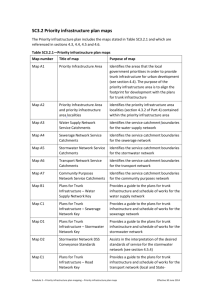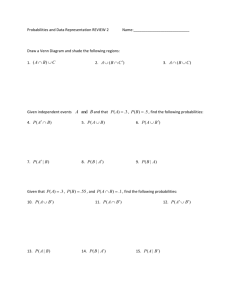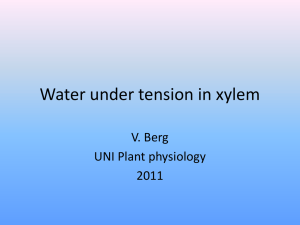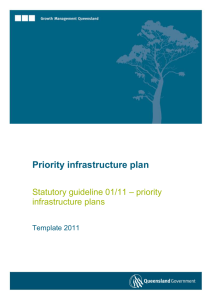DOC - Moreton Bay Regional Council
advertisement
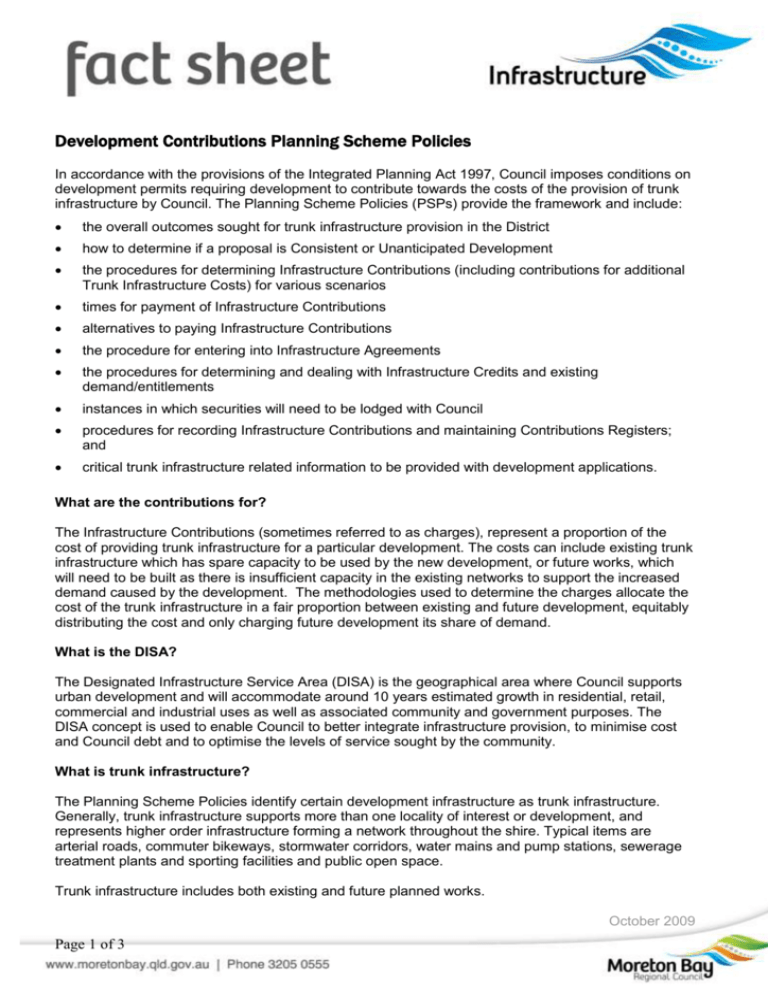
Development Contributions Planning Scheme Policies
In accordance with the provisions of the Integrated Planning Act 1997, Council imposes conditions on
development permits requiring development to contribute towards the costs of the provision of trunk
infrastructure by Council. The Planning Scheme Policies (PSPs) provide the framework and include:
the overall outcomes sought for trunk infrastructure provision in the District
how to determine if a proposal is Consistent or Unanticipated Development
the procedures for determining Infrastructure Contributions (including contributions for additional
Trunk Infrastructure Costs) for various scenarios
times for payment of Infrastructure Contributions
alternatives to paying Infrastructure Contributions
the procedure for entering into Infrastructure Agreements
the procedures for determining and dealing with Infrastructure Credits and existing
demand/entitlements
instances in which securities will need to be lodged with Council
procedures for recording Infrastructure Contributions and maintaining Contributions Registers;
and
critical trunk infrastructure related information to be provided with development applications.
What are the contributions for?
The Infrastructure Contributions (sometimes referred to as charges), represent a proportion of the
cost of providing trunk infrastructure for a particular development. The costs can include existing trunk
infrastructure which has spare capacity to be used by the new development, or future works, which
will need to be built as there is insufficient capacity in the existing networks to support the increased
demand caused by the development. The methodologies used to determine the charges allocate the
cost of the trunk infrastructure in a fair proportion between existing and future development, equitably
distributing the cost and only charging future development its share of demand.
What is the DISA?
The Designated Infrastructure Service Area (DISA) is the geographical area where Council supports
urban development and will accommodate around 10 years estimated growth in residential, retail,
commercial and industrial uses as well as associated community and government purposes. The
DISA concept is used to enable Council to better integrate infrastructure provision, to minimise cost
and Council debt and to optimise the levels of service sought by the community.
What is trunk infrastructure?
The Planning Scheme Policies identify certain development infrastructure as trunk infrastructure.
Generally, trunk infrastructure supports more than one locality of interest or development, and
represents higher order infrastructure forming a network throughout the shire. Typical items are
arterial roads, commuter bikeways, stormwater corridors, water mains and pump stations, sewerage
treatment plants and sporting facilities and public open space.
Trunk infrastructure includes both existing and future planned works.
October 2009
Page 1 of 3
Existing trunk infrastructure is valued at its current replacement cost. Future planned works are
valued at their net present value: that is, the current estimated cost of the project is escalated by
anticipated increases in costs to the date of expected construction, and then discounted back to
current day dollars to take into account financing costs and the changing value of money over time.
What are service catchments?
Service catchments are geographical areas logically grouping demand for trunk infrastructure and
therefore future works. Typical service catchments for each network are:
Traffic zones for transport
Areas of similar development patterns for open space
Drainage catchments for stormwater following topographical features
Water supply zones serviced from a common water source
Sewerage treatment plant catchments
Allocating the costs of infrastructure to service catchments and therefore to the demand originating
from that catchment results in an equitable distribution of charges according to the ‘user pays’
principle required to be followed by Council under the guidelines set under the Integrated Planning
Act.
What is demand?
Council provides infrastructure to meet essential community needs. The level of this need and how it
is measured is called demand. To plan for growth in the region, assumptions are made about
population, occupancy levels, development density, floor space and employees, which are then
translated into demand on the network either for a catchment or on a per lot basis. The demand per
lot (residential and non-residential) is referred to as the demand assumption.
How does the charging work?
For each catchment in each network, the total trunk infrastructure cost is divided by the total demand
relevant to arrive at a charge rate. The charge rates are expressed as a $ rate per demand unit. The
charge rates are adjusted by the CPI quarterly to reflect changes in the value of trunk infrastructure.
For a particular development, the contribution is determined as follows:
Infrastructure Contribution = {A – B – C} x $ rate per demand unit x administration, summed for all
networks
A: represents the total demand of the proposal after the development has been implemented
B: represents the demand of any existing lawful use
C: represents any credits for the provision of trunk infrastructure
The demand on the networks expected to be generated by the development is determined by using
the demand tables in Schedules A of the network policies. A, B and C are expressed in Demand Units
for a network.
The net demand resulting from A – B – C is the basis of the required contribution.
The net demand is then multiplied by the charge rate current at the time to arrive at a total
contribution for each network. An administration charge is added on to this.
Page 2 of 3
The contributions for each network are then added together to arrive at a total Infrastructure
Contribution amount. The capping policy of Council is then applied to limit the maximum amount
payable per lot.
Refer to additional fact sheets for the determination of existing demand, infrastructure credits and
rebates and application of the capping policy.
Why is an administration component applied?
The administration component represents the expenditure incurred by Council in creating, planning,
amending and maintaining the planning scheme policies and plans for trunk infrastructure. This
expenditure is not included in any of the trunk infrastructure costs.
This administration component is allowed to be included under the Act, guidelines and the Standard
Infrastructure Charges Schedule November 2008.
Page 3 of 3




